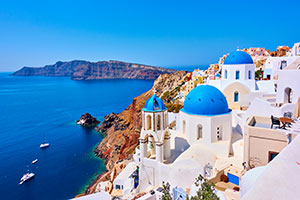Say opa to 8 days of ancient wonders and sunlit island vibes! Start your Greek adventure in Athens before heading to Delphi to explore the legendary Temple of Apollo. In Kalambaka, see the monastery perched high in Meteora. Then it’s time to hit the Aegean with a cruise to Mykonos, the incredible ruins of Ephesus and peaceful Patmos. Top it all off with Santorini’s iconic cliffside views. A little history, a little sunshine and a whole lot of fun!
Patmos
Patmos
This island is known as the site of the apocalyptic Revelations of St. John the Divine, written here during his exile from the Roman Empire. The cave where he lived is near the site of the Monastery of the Apocalypse. The Monastery of St. John, built on one of the island's highest points, houses priceless icons and manuscripts in its Treasury.
|
Destination Guide
|
Mykonos
Mykonos
Mykonos's many captivating attributes make it one of the most celebrated Greek holiday islands. Its main village is a colorful maze of narrow streets lined with white-washed houses, many with bright blue doors and shutters. As an attractive backdrop, famous windmills are lined up like toy soldiers on the hillside, vestiges of a time when wind power was used to grind grain. Mykonos has churches and chapels scattered about the island; quite a number of them are located right in town. Radiant flowers spill over white-washed walls and shady courtyards. In addition to swimming, sunning, water-skiing and surfing, visitors find endless shopping opportunities. Artists have relied on Mykonos' beautiful setting to inspire them. The most photographed site is the Paraportiani, a cluster of white-washed churches resting below windmills. Mykonos's museums include an Archaeological Museum, which houses relics from the Trojan War, a Folk Art Museum and a Maritime Museum. The best beaches are Aghios Stephanos, Psarou, Kalafatis, Onros, Panormos and Elia.
|
Destination Guide
|
Santorini
Santorini
Santorini is everything that has made the Greek islands legendary. The world famous island of Santorini is the southern most island of the Cycladic group in the Aegean Sea, and is located north of Crete. Its population is distributed among thirteen villages and just exceeds nine thousand. The marvelous dry climate and unbroken sunshine create year around conditions which are perfect for observation, photographs and videos under an extraordinary variety of natural lights and colors.
|
Destination Guide
|
Crete
Crete
Crete is the largest of the Greek islands, lying at the southern limit of the Aegean Sea.
Among the artists who lived on Crete was El Greco, who was born near Heraklion in 1541. The area around the harbor and the side streets are lined with souvenir and handicraft shops. Jewelry, olive and honey products may be of interest.Tavernas along the harbor front offer tasty local dishes. Spinalonga Island is located 15 miles from Ághios Nikólaos. Formerly the site of a leper colony, the island is popular with sun worshippers who enjoy its picturesque setting. Other attractions include the remains of a 16th-century Venetian fort.
|
Destination Guide
|
Kusadasi (Ephesus)
Kusadasi (Ephesus)
Visitors come to Kusadasi for beaches and nearby ruins of Ephesus. The major attraction is the archaeological site of ancient Ephesus, considered to be most important in Turkey. The history of this ancient city dates back to 10th century BC; many remarkable structures seen today are result of an excavation and restoration program. Along a white marble road grooved by ancient chariot wheels, the two-story Library of Celsus presents a striking sight. There are temples, houses of noblemen, and community buildings lining ancient streets. Nestled in the mountainside is a 25,000-seat amphitheater, still used for performances during Festival of Culture and Art. Bible buffs may know Ephesus as inspiration for St. Paul’s Epistle to Ephesians and the site of one of the first seven churches of Asia Minor. Treasures are kept in the Seljuk Archaeological Museum. Among the better-known ancient sites near Kusadasi are ancient Miletus and Dydima. Remains include a well-preserved Roman theater at Miletus and Dydima's sacred temple of Apollo.
|
Destination Guide
|
Kalambaka
Kalambaka
Kalambaka is a small modern town with near Meteora. The most interesting feature of the town is the dramatic backdrop of the steep Meteora rocks that frame the northern part of the skyline. The town is clean and quiet, with one main street that runs through it like a backbone, and several squares adorned with lavish fountains that become pivot points for families and boisterous children late in the evening. Most restaurants and cafes are located along the main street and in the few side streets in the center of town.
|
Destination Guide
|
Delphi
Delphi
Itea is the port for Delphi, one of the ancient wonders of classical Greece. A short drive there reveals the Sacred Way and the famed Shrine of Delphi, where the mythological Oracle was said to foretell the future. An amazing bronze charioteer is among the many treasures in the Delphi Museum.
|
Destination Guide
|
Athens
Athens
Even though you've probably come here to see the "glory that was Greece," perhaps best symbolized by the Parthenon and the superb statues and vases in the National Archaeological Museum, allow some time to make haste slowly in Athens. Your best moments may come sitting at a small cafe, sipping a tiny cup of the sweet sludge that the Greeks call coffee, or getting hopelessly lost in the Plaka -- only to find yourself in the shady courtyard of an old church, or suddenly face to face with an ancient monument you never knew existed. With only a little advance planning, you can find a good hotel here, eat well in convivial restaurants, enjoy local customs such as the refreshing afternoon siesta and the leisurely evening volta (promenade or stroll) -- and leave Athens planning to return, as the Greeks say, tou chronou (next year).
|
Destination Guide
|






